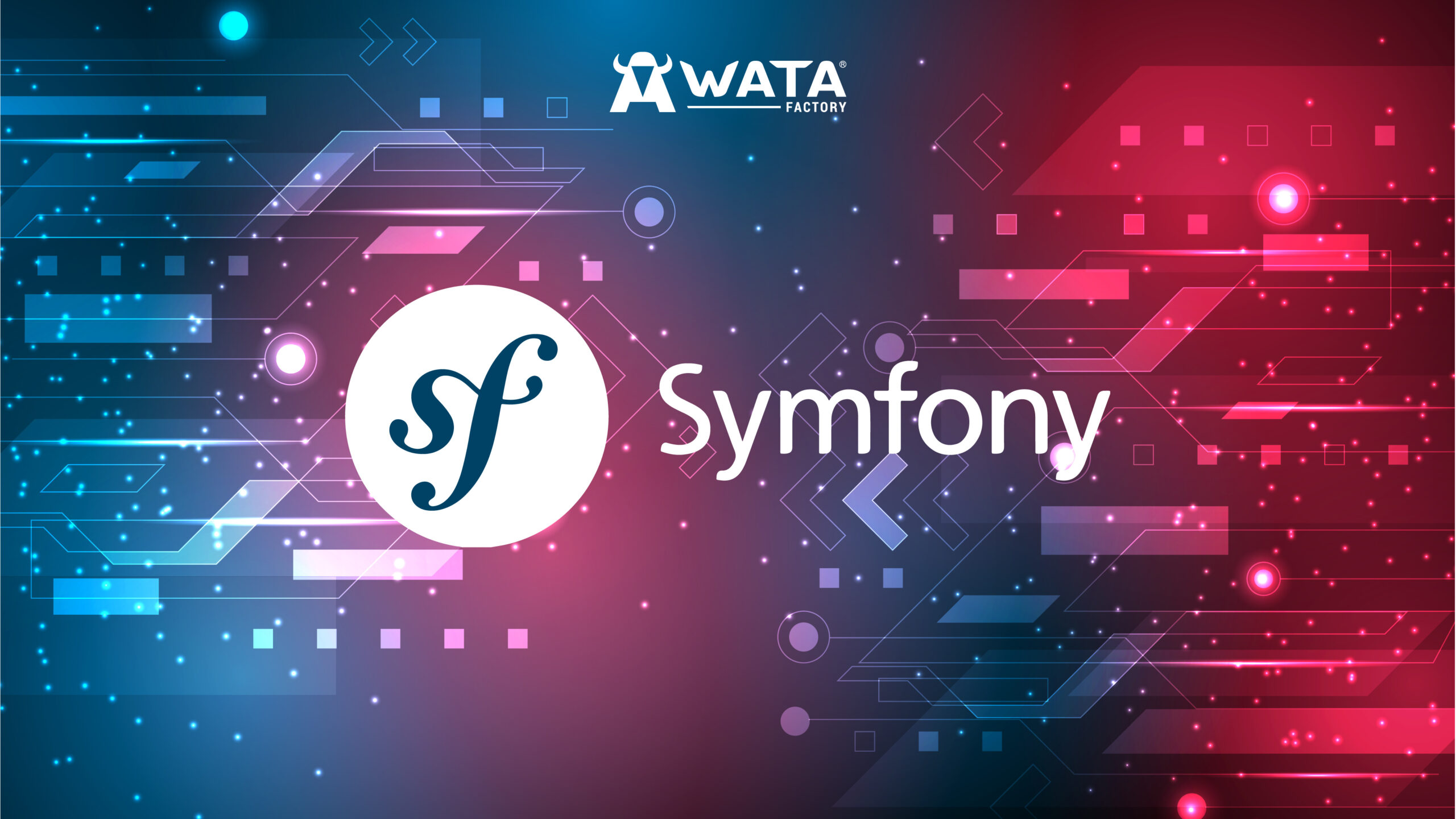At WATA Factory, we have spent the last decade working with Symfony, a framework that has proven essential as web applications grow in complexity. With increased demand for robust, flexible, and efficient solutions, the choice of framework becomes critical. Symfony, a leading PHP framework, has consistently been our preferred tool for developing scalable and maintainable web applications across a wide range of projects.
Whether you’re an experienced PHP developer or transitioning from a different programming background, this guide offers a comprehensive overview of Symfony’s fundamental concepts and key advantages. It explains why we, at WATA Factory, have fully integrated it into our development workflow, and how it helps us meet the growing demands of modern web development with reliability and precision.
What is Symfony?
Symfony is an open-source PHP framework designed to streamline web application development by providing a set of reusable components and a solid foundation for building high-performing applications. Created by SensioLabs and released under the MIT license, Symfony adheres to the Model-View-Controller (MVC) architectural pattern, promoting code organization and reusability.
Key Features of Symfony
Symfony stands out as one of the most powerful and flexible PHP frameworks, known for its ability to handle projects of varying scale and complexity. Below are some of the key features that make Symfony an exceptional choice for web development:
- Reusable Components: Symfony is built upon decoupled and reusable components that can be used independently in any PHP project.
- Flexibility: With its modular architecture, developers can customize and replace core parts without affecting the entire system.
- Performance: Symfony is optimized for performance, enabling the development of fast and efficient applications.
- Community Support: A large and active community contributes to continuous improvements, extensive documentation, and a plethora of third-party bundles.
- Best Practices: Symfony enforces coding standards and best practices, ensuring code quality and maintainability.
At WATA Factory, Symfony plays a pivotal role in our development process. Its flexibility and performance enable us to deliver high-quality, scalable web applications that meet the growing demands of our clients. By embracing the best practices enforced by Symfony and leveraging its reusable components, we ensure that our projects are not only efficient but also maintainable for the long term. This makes Symfony a fundamental tool in helping us build reliable, future-proof solutions for our clients.
Symfony Components
One of Symfony’s standout features is its collection of reusable components. These are standalone PHP libraries that solve common tasks:
- HttpFoundation: Replaces the traditional PHP global variables with an object-oriented layer.
- Routing: Maps URLs to specific controllers and actions.
- DependencyInjection: Manages object creation and dependency management through a robust service container.
- EventDispatcher: Implements the Observer pattern, allowing components to communicate efficiently.
- Twig: A flexible, secure, and fast template engine for PHP.
These components are not only used within the Symfony framework but are also adopted by other projects like Laravel and Drupal.
Bundles in Symfony
Bundles in Symfony are akin to plugins or modules in other frameworks. They are self-contained packages that add specific functionality to your application. Bundles can be anything from a user authentication system to an admin dashboard. Symfony encourages code reusability by allowing developers to share and distribute bundles within the community.
The Symfony Architecture
When using Symfony for web applications development, one of the first concepts you will find out is that Symfony follows the MVC pattern, which separates an application into three main logical components:
- Model: Manages the data and business logic.
- View: Handles the presentation layer and user interface.
- Controller: Acts as an intermediary between the Model and View, processing user input and interacting with the Model.
This separation of concerns enhances code organization and makes it easier to manage and scale applications.
Request-Response Lifecycle
Understanding Symfony’s request-response lifecycle is essential for mastering how web applications interact with clients. This lifecycle forms the backbone of how Symfony processes HTTP requests, enabling developers to build structured, efficient, and maintainable applications. By breaking down the communication between the client and server into clear steps, Symfony ensures that each stage of the interaction is handled systematically and transparently.
Here is an overview of the key steps in Symfony’s request-response lifecycle:
- Request: The process begins with the HttpFoundation component capturing the incoming HTTP request. This component gathers all necessary information from the client request, such as headers, query parameters, and data.
- Routing: Next, the Routing component takes over, mapping the request to a specific route. Based on the request URL, it determines which controller should handle the logic for this request.
- Controller: The designated controller receives the request and processes it. This often involves interacting with models, accessing databases, and utilizing services to fulfill the client’s needs.
- Response: Once the controller has processed the request, it returns a Response object. This object contains the data or webpage that will be sent back to the client, completing the cycle.
This structured flow ensures a clear and efficient process for handling client-server interactions, reducing complexity and allowing developers to focus on building features rather than managing low-level request handling.
Getting Started with Symfony
Installation
Symfony utilizes Composer for installation and dependency management. To create a new Symfony project:
composer create-project symfony/website-skeleton my_project
Alternatively, you can use the Symfony CLI:
symfony new my_project –fullDirectory Structure
A typical Symfony project has the following structure:
- src/: Contains your PHP code (controllers, entities, services).
- templates/: Holds your Twig templates for the view layer.
- config/: Configuration files for bundles and services.
- public/: The web root directory, containing the front controller (index.php).
Basic Configuration
Symfony uses YAML, XML, or PHP annotations for configuration. For example, routing can be defined in config/routes.yaml:
home:
path: /
controller: App\Controller\DefaultController::indexCreating a Controller
A simple controller might look like:
// src/Controller/DefaultController.php
namespace App\Controller;
use Symfony\Bundle\FrameworkBundle\Controller\AbstractController;
use Symfony\Component\HttpFoundation\Response;
class DefaultController extends AbstractController
{
public function index(): Response
{
return $this->render('home.html.twig');
}
}Templating with Twig
Twig templates are stored in the templates/ directory:
{# templates/home.html.twig #}
<!DOCTYPE html>
<html>
<head>
<title>Welcome to Symfony</title>
</head>
<body>
<h1>{{ message }}</h1>
</body>
</html>Running the Application
Start the built-in PHP web server:
symfony server:startVisit http://localhost:8000 to see your Symfony application in action.
Symfony vs. Other Frameworks
While Symfony is a PHP framework, its design principles and architecture resonate with developers familiar with other programming languages and frameworks. Symfony’s robustness, flexibility, and focus on best practices make it stand out, particularly in environments that demand scalability, maintainability, and customization. Let’s explore how Symfony compares to some of the most popular frameworks, both within PHP and beyond:
- Laravel (PHP): Laravel is often seen as a direct competitor to Symfony, given that both are PHP-based frameworks. In fact, Laravel integrates several of Symfony’s core components, such as the HttpFoundation and Routing components. However, Laravel differs in its approach. It offers a more opinionated and expressive syntax, making it particularly attractive to developers seeking rapid development with a clear, straightforward path. Laravel is designed with ease of use in mind, prioritizing developer experience and quick results, which makes it ideal for small to medium projects. Symfony, on the other hand, offers more granular control and flexibility, making it a better fit for complex, enterprise-level applications where custom architecture and scalability are key. Symfony’s more modular approach allows developers to use only the components they need, whereas Laravel provides a more monolithic structure with a built-in set of conventions that guide development.
- CodeIgniter(PHP): CodeIgniter is lighter and simpler, making it an ideal choice for small to medium-sized projects. Its learning curve is lower, and it doesn’t require as many components or advanced configurations, allowing for fast and agile development. However, because CodeIgniter is less strict with conventions and standards, knowledge transfer between developers, especially in teams with high turnover, can become complicated, as the code might not always adhere to uniform practices. In summary, Symfony offers more control and scalability, whereas CodeIgniter focuses on simplicity and development speed.
- Yii2(PHP): Yii2 stands out for its performance and simplicity, offering a balance between flexibility and ease of use. Although it is also suitable for large projects, Yii2 is lighter and takes a more pragmatic approach. It includes an efficient ORM called ActiveRecord, and its template engine is less restrictive than Symfony’s, allowing the use of PHP directly in views. Additionally, Yii2 is known for its high development speed, thanks to features such as automatic code generators and a shorter learning curve.
- Ruby on Rails (Ruby): Ruby on Rails (often just “Rails”) shares several conceptual similarities with Symfony, most notably its use of the Model-View-Controller (MVC) architecture. Both frameworks emphasize the separation of concerns, ensuring that business logic, data handling, and presentation layers remain distinct. One of Rails’ defining principles is “Convention over Configuration,” which allows developers to write less code by adhering to conventions that the framework enforces. Symfony, while also promoting best practices, offers more configuration options, giving developers the flexibility to tailor their applications to specific requirements rather than being confined to conventions. This makes Rails a strong choice for developers who prefer quick, convention-driven development, whereas Symfony shines in projects where custom configurations and reusable components are crucial for handling intricate business logic.
- Django (Python): Like Symfony, Django is a powerful framework that promotes clean, pragmatic design and rapid development. Django’s “batteries-included” philosophy provides everything developers need right out of the box, from authentication to templating to database management, making it highly efficient for rapid development cycles. Symfony, in contrast, provides a more component-based structure, allowing developers to choose only the parts they need for their specific application. This modularity gives Symfony the upper hand in terms of flexibility, especially for large-scale, complex projects where the ability to swap or customize individual components is essential. While both Django and Symfony are known for their emphasis on best practices, Symfony’s flexibility and integration capabilities with other libraries and systems make it more suited for highly complex, enterprise-level applications, whereas Django often excels in delivering fast, ready-to-use solutions.
Why Symfony Stands Out
Symfony’s defining feature is its emphasis on reusable components. Unlike many frameworks that come as all-in-one solutions, Symfony allows developers to use only the parts of the framework they need. Its decoupled architecture means that you can integrate individual components—like the HttpFoundation, DependencyInjection, or EventDispatcher—into any PHP project, regardless of whether you’re using the full framework. This flexibility gives Symfony a distinct advantage in complex, enterprise-level applications where modularity, customization, and integration with existing systems are essential.
Additionally, Symfony’s commitment to best practices and adherence to industry standards (such as PSR compliance) ensure that developers are working within a framework designed to foster maintainable, long-term projects. Symfony’s built-in tools, such as the profiler and debugging toolbar, enhance developer productivity while maintaining code quality.
Moreover, Symfony’s ecosystem and community provide an extensive range of third-party bundles that extend its core functionality, saving development time and reducing the need to “reinvent the wheel.” Its long-term support (LTS) versions also make Symfony a strong candidate for projects where stability and long-term maintenance are crucial considerations.
Conclusion
At WATA Factory, we’ve experienced firsthand how Symfony stands out as a robust framework that promotes best practices and efficient development workflows. Its component-based architecture not only benefits PHP developers but also offers concepts and patterns applicable across various programming languages. By embracing Symfony in most of our projects, we’ve been able to build scalable, maintainable, and high-performing web applications.
Whether you’re new to PHP or an experienced developer exploring new frameworks, we at WATA Factory believe that Symfony provides the tools and community support to elevate your web development projects.



